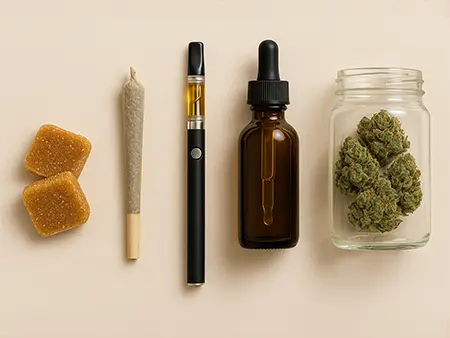
You have more cannabis options available to you today than ever before. Different methods of consumption have different rates of absorption, which affects time of onset, duration, and levels of psychoactivity; understanding this will help you enjoy a truly customized experience.
Inhalation
While studies have shown that even decades of smoking cannabis is not associated with higher risks of lung disease, combustion is still not the healthiest alternative. Vaporizers (and vape pens) work by heating the smoking substance to a temperature hot enough to vaporize the plant material but not burn it, which releases the cannabinoids and terpenes. Inhalation methods range from the simplest pre-rolled joint to the most advanced tabletop vaporizer, along with the daunting array of attachments, accessories, and options they offer. Vape pens are a popular choice because they are simple, discreet, portable, tasty, and let’s face it, fun, but you’ll find a wide variety of all sorts of smoking/vaping options here at Sespe.
Oral/Mucosal
If you need something more discreet, or prefer not to smoke or vape, the next quickest route is through the mucous membranes of the mouth. Tinctures, hard candies, sprays or strips, and gum all fall under this category. The longer you hold it in your mouth, the more will be absorbed through the sublingual and buccal surfaces (under the tongue and inside the cheek, respectively); like inhalation, the medicine passes directly into the bloodstream. Still, some of it will be swallowed and processed through the digestive tract before the effects are felt, so the rule to wait at least an hour and a half still applies.
Ingestion
For first timers, experts recommend a very small (5 – 10mg) dose. We urge you always to err on the side of caution, and keep in mind that the rate of absorption and the duration will be different for different individuals, depending on when and what you ate last, and your own unique metabolism. In spite of all these variables, once you have established what works for you, you’ll know exactly how much you want to take. Modern edibles are very consistent in potency and dosage.
Topical/Transdermal
Topical cannabis preparations work locally and are non-psychoactive. Cannabis is capable of exerting its effects directly on the body without first being processed through the system because the skin is absolutely packed with cannabinoid receptors. CB1 and CB2 receptors are found in epidermal keratinocytes (which are 90% of all skin cells), nerve fiber bundles, mast cells, macrophages, and the epithelial cells of hair follicles, sebocytes and sweat glands. In addition to this, recent research has revealed that multiple members of the transient receptor potential (TRP) ion channel family can act as cannabinoid receptors, and the skin is full of those as well. These TRP channels are involved in numerous processes including temperature and itch perception, the initiation of pain, the maintenance of skin homeostasis, the regulation of hair follicles and sebaceous glands, immune response, and the modulation of inflammation, among other things.
